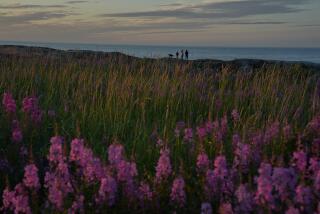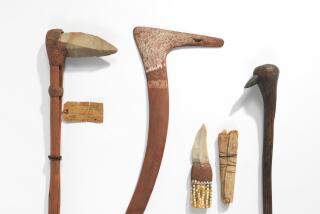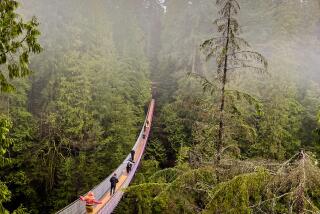Fancy Artifacts Found in Dig at Poor Village in the Northwest
VANCOUVER, Wash. — Jeff Isaak plunged his fingers into dirt where a humble home site stood 150 years ago, plucked out a tiny piece of ceramic and handed it to archeologist Doug Wilson.
“Staffordshire transfer print, blue and white,” Wilson said at a glance.
That was fancy stuff for the village of the working poor that supported the once-mighty Hudson’s Bay Co. at Ft. Vancouver and its vast empire in the Northwest in the early and mid-1800s.
What the Staffordshire and other signs of relative affluence were doing under the dirt-floor homes of dirt-poor workers nobody is sure. Little is known of the village and the people who worked and lived there.
But with paintbrushes and trowels, student archeologists scraped away this summer at the village, the underbelly of the Hudson’s Bay operation.
The farmers, laborers, woodcutters, coopers, bakers and blacksmiths didn’t leave much because they didn’t have much.
But from the trade rings and clay pipestems, bits of ceramics, knives, beads and bones, a look at their lives has begun to emerge.
The five-week project was run jointly by Portland State University and the National Park Service and will be resumed next summer. The dig is located outside the walls of the fort, which was restored on its original site in 1966.
From its founding in 1825 until about 1860, the fort supplied food, tools and other supplies to fur trappers and its 20 or so outposts throughout the Northwest.
It was put there by the British to cement their disputed claim to the Oregon country, to squeeze Americans out and keep peace with the Indians.
The company’s main business, however, was furs, which it bought in immense quantities and shipped to England for the hat trade.
Much to England’s displeasure, weary pioneers at the end of the Oregon Trail didn’t get the cold shoulder from the man who ran Ft. Vancouver, Dr. John McLoughlin. They got food, tools, credit and other aid that allowed them to counter the British presence with their own.
When the Northwest went to the United States in 1846, the Canadian-born physician moved to Oregon City, became an American citizen and is known today as the “Father of Oregon.”
The fort and its support base were the beginning of agriculture, lumbering and fishing in the Northwest.
“Missionaries called it ‘the New York of the West,’ where you could buy European goods in the wilderness,” said Wilson, who is in charge of archeology at the Vancouver National Historic Reserve. “The reports got people jazzed about coming West.”
Hudson’s Bay officers and clerks lived in relative comfort within the fort.
But the food, the lumber, the blacksmithing and other necessities that fueled the company’s empire had to come from somewhere. An order sent home to England wouldn’t arrive for two to three years.
Enter the “engages,” who may have numbered 600 to 1,000 and lived a cruder life in simple huts outside the fort walls.
It is their village that is drawing the attention of archeologists bent on finding out who these people were and what their lives were like.
“There were French Canadians, Hawaiians, Indians, Russians, Scots and English, and they all seemed to live in relative harmony here,” Wilson said. “Most were illiterate, so they didn’t write anything. All we know was written by the people in the fort and by the missionaries, and it’s a pretty biased view, an imperfect view of the village.”
A Hawaiian laborer got 10 pounds a year; other common workers got 17 pounds. Skilled engages did a little better. McLoughlin, the “chief factor,” might have expected 600 to 800 pounds if the company had a good year.
But low wages aside, excavators found signs of unexplained affluence.
Isaak said 98% of the china they are finding is Spode, the supplier to the royal family and a Hudson’s Bay monopoly at the time.
“It’s interesting to find china like what was on the chief factor’s table, where the gentlemen ate, out here in the village,” Wilson said.
One answer, he said, is that as things wore out in the fort, they were recycled down to the villagers. Or the engages, some of whom lived in the village for many years, may have gotten desperate for something special, hang the cost.
“We’re finding shagreen enamel designs,” said Shingo Hamada, one of the students patiently probing the home site. “It was expensive. They had been finding that only inside the fort. The question is, why are we finding it in the houses. Hudson’s Bay laborers lived here.”
Bits of Chinese porcelain also showed up. “Chinese porcelain isn’t supposed to be here,” Isaak said. “That’s East India Co.”
Stone flakes also have turned up, a sign that the Indian women many of the engages married retained their native ways.
A laboratory at the fort analyzes what is found, from bones, to determine what people ate; to tiny beads the size of a seed; to bits of glass and ceramics.
A small display in the laboratory includes a dime and a quarter from the 1830s that were perforated, apparently for use in a necklace.
The seemingly endless bits of pipe stems confirmed a popular pastime.
“Smoking was the thing to do,” said park guide Edward Reidell, who also directs some archeological projects. “Men, women, kids, they all smoked. “
The company stayed at the fort for a few years after the Northwest went to the United States, but withdrew to Canada as the U.S. Army moved in. The Army moved off the villagers. Decay and fire destroyed what was left of the village by 1866.
But the site continues to yield clues to the hazy histories of the village residents. The village area and the fort site have given up more than 1.5 million artifacts since explorations began in 1948. Findings go to a lab in the fort for analysis and cataloging.
“The village was an amazing place. It is the premiere archeological site in the Pacific Northwest, and it’s important that the story not be lost,” Wilson said.
*
On the Net:
Fort Vancouver National Historic Site: https://www.nps.gov/fova.
More to Read
Sign up for Essential California
The most important California stories and recommendations in your inbox every morning.
You may occasionally receive promotional content from the Los Angeles Times.










